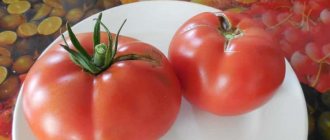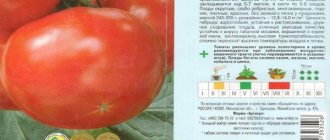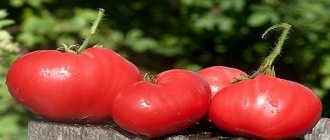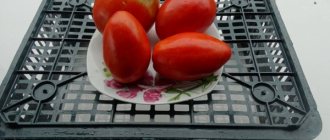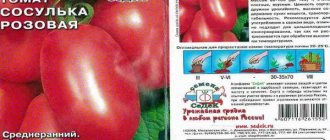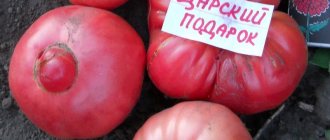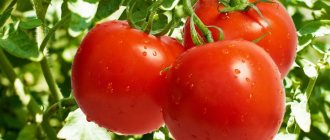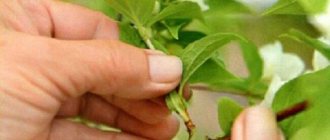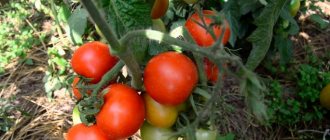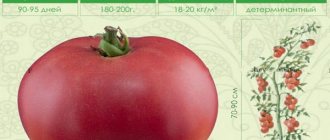Tomato Heart of Ashgabat is a mid-season variety, bred during the Soviet era and deserves attention. Designed for cultivation in the southern regions. This fruitful and tasty tomato will especially appeal to lovers of yellow tomatoes.
| Height | Landing location | Ripening time | Fruit color | Fruit size | Origin | Fruit shape |
| Medium height | Greenhouse, Open ground | Mid-early | Yellow | Average | Variety | Heart-shaped |
History of the development of the tomato variety Heart of Ashgabat
Most often, the Heart of Ashgabat variety is grown in the southern regions, which is not surprising, but in protected soil it can grow well and bear fruit throughout our country. It has become especially easy to grow it with the advent of modern polycarbonate greenhouses. In regions such as the Astrakhan and Rostov regions, Stavropol region, Crimea, and the Heart of Ashgabat, they are successfully grown in open ground.
Country of origin and year of registration
The variety was developed in the Turkmen SSR in the 1960s, and it received state registration in 1972.
Planting and care
Tomato planting is carried out using the seedling method. To do this, the seeds are sown in moist humus soil located in containers. The resulting seedlings are covered with polyethylene film and care is taken that the room temperature does not fall below 18 degrees.
When seedlings with 2 leaves and a stem are formed, they are planted in separate pots. On day 60, the bushes are transplanted into open ground or into a greenhouse.
When planting, maintain a distance between seedlings for ease of work and proper nutrition of the plant. Use a 50x50 cm pattern.
Care involves regularly watering the tomatoes with warm water when the top layer of soil dries out. Between waterings, it is necessary to weed and loosen the soil, which gives oxygen to the roots and protects the plant from fungal diseases. At all stages of growth, complex fertilizers are applied.
Description of the variety Heart of Ashgabat
The Heart of Ashgabat tomato is considered a semi-determinate standard variety; its bush grows up to one and a half meters high. The foliage is average. The formation of a bush is mandatory; usually it is grown in 2 or 3 stems, tying them to supports. 4 plants are kept per square meter. The variety is slightly affected by late blight and other tomato diseases, but during periods of prolonged rain the fruits are prone to cracking.
Not all fruits are the same in size, even the shape can vary
The variety is considered mid-early: the first fruits ripen 100–110 days after sowing the seeds for seedlings or, in the south, directly into the garden bed. Productivity is above average: up to 7 kg of tomatoes are harvested from one bush.
As the name suggests, the fruits are heart-shaped. They are quite large: on average they grow up to 300–400 g, but the first tomatoes on the bush can reach up to half a kilogram and contain 6 or 7 chambers. The color is bright yellow, closer to orange when fully ripe. Tomatoes store well and are suitable for transportation over medium distances.
The number of seeds is small, the pulp is fleshy, aromatic, very good taste, sweetish, practically without sourness. Some gardeners call the Heart of Ashgabat one of the best yellow-fruited varieties. The purpose is salad, but in addition to fresh consumption, the fruits are also suitable for processing. Whole-fruit canning in jars is difficult due to the size of tomatoes, so yellow tomato juice is mainly prepared from them. The fruits are suitable for producing a dried product. The variety is recommended for dietary nutrition.
The most accurate characteristic of fruits is fleshiness and original taste.
General description of the variety
The heart of Ashgabat is the varietal tomato. It was bred in the USSR by Turkmen breeders. The name and surname of the originator are unknown, so the tomato is called the development of folk selection.
In 1972, the tomato was included in the Russian state register. Since then, its popularity has not diminished.
Advice . The largest tomatoes are allowed to fully ripen on the bushes. Their seeds are collected, cleared of pulp and stored in fabric bags. It is from such planting material that the strongest and most productive plants are obtained.
Distinctive features
The heart of Ashgabat is distinguished by large, beautiful fruits. They are bright orange in color, with small pinkish spots. Their shape resembles a heart, which is why the variety got its name.
Tomato berries are fleshy and juicy. They have a rich sweet taste with unexpressed sourness. Tomato aroma.
The fruits have a high content of beta-carotene and lycopene. Thanks to this, they help remove harmful substances from the body, improve vision and strengthen the immune system. Moreover, such tomatoes do not cause allergies and have a low concentration of purines. They are useful for children, allergy sufferers and people suffering from vitamin deficiency.
Tomato has a high yield.
Another positive quality of the Heart of Ashgabat is the high immunity to fungal diseases of tomato crops. The variety is not afraid even of late blight.
Like most other tomatoes, it is demanding of light and temperature. The variety is not cold-resistant. Also among the disadvantages of the Heart of Ashgabat, gardeners include the fact that it will not produce a good harvest without regular and proper fertilizing.
Features of the plant
Tomatoes of the Heart of Ashgabat variety are mid-early, since the period between planting seeds and receiving the first ripe fruit is about 100-110 days.
The description of the variety includes the following characteristic features:
- semi-derminant plants that reach a height of 110-140 cm;
- bushes form into 2-3 stems and need to be tied to a support;
- it is necessary to carry out stepsoning;
- the yield of 1 bush is 6-7 kg (about 30 kg per 1 m²);
- optimal planting density – 4-5 bushes per 1 m²;
- tomatoes can be stored for a long time and have high transportability.
Tomatoes of this variety can be grown in any conditions (in greenhouses and unprotected soil).
The Heart of Ashgabat tomato has characteristic fruits of bright yellow color, reminiscent of a golden heart. The weight of 1 tomato can reach 250-350 g. Tomatoes of the first harvest can weigh from 400 to 600 g. The fruits have 6-7 chambers, dry matter is no more than 6%.
Heart of Ashgabat tomatoes are mainly consumed fresh. However, processed fruits retain their beneficial properties. For example, juices made from these golden yellow tomatoes are very healthy. Tomatoes of this color can be consumed by people on a diet or who have an allergic reaction to red foods.
For canning, it is better to use small-sized tomatoes, leaving larger ones for barrel pickling.
Photo of tomato Heart of Ashgabat
You can see photos of the “Heart of Ashgabat” tomato variety below:
Description of fruits
Ripe tomatoes are bright yellow in color and heart-shaped. The size is quite large, weight 250-600 g. The consistency of the fruit is fleshy with a small number of seeds. The taste is pleasant, sweetish.
Basic qualities of fruits
The tomatoes are heart-shaped, bright orange in color, weighing 200-500 grams. The pulp is fleshy, juicy, aromatic, low in seeds. The taste is sweet, no acid at all. The purpose of the variety is salad. Recommended for dietary nutrition.
Bush care
In the future, the plantings must be cared for as follows:
- Watering. Water no more than twice a week, but generously. During particularly dry and windless periods, water more often, and also provide plants with protection from the scorching rays of the sun;
- Bush formation. Form a plant into two or three stems;
- Tying. Bushes need to be tied to a support;
- Stepsonning . Stepchildren are planted as the bush grows;
- Feeding. During the season, 3-4 feedings are carried out using complex fertilizers.
Main characteristics
The popularity of the variety is due to its impressive characteristics and tasty fruits. In terms of productivity and disease resistance, it is not inferior to younger breeding achievements.
A detailed description of the Heart of Ashgabat is given in the table
| Parameter | Indicators |
| Bush type | Semi-determinant, standard. The height of the main stem varies between 100-140 cm. The leaves are medium-sized, simple, light green in color. The bushes are powerful, with a small number of leaves. The inflorescences are simple, the first is formed at the level of 6-8 leaves, the next after 1-2 leaves. The fruits are formed in clusters of 2-4 pieces. |
| Growing method | Cultivated in open and protected ground. |
| Productivity | High. From 4-7 kg of fruits are collected from one bush. From 1 sq. m get from 20 to 30 kg of harvest. |
| Fruit | Large size. On average, the weight of one fruit reaches 250-500 g. Individual specimens weigh 600-800 g. The color of the fruit is bright orange inside and out. There are pinkish spots. There is no green area at the base. The shape is heart-shaped, sometimes with a point at the tip, sometimes not. There is pronounced ribbing at the base, thanks to which the berries resemble a heart. There is a lot of pulp and it is juicy. The dry matter content does not exceed 6%. The taste is sweet without sourness. The number of seed chambers in each fruit does not exceed 7 pieces. |
| Transportability | High. The fruits are not damaged during transportation and are stored for more than a month. |
| Ripening time | Mid-season variety. The berries ripen 110-115 days after sowing the seeds. |
| Disease resistance | It is resistant to fungal diseases of tomatoes. |
Productivity
The variety has a very high yield. With proper agricultural technology, one bush yields 6-7 kg and about 30 kg per square meter.
Features of cultivation
In unprotected soil, “Heart of Ashgabat” is best grown in southern regions, such as Crimea, Rostov or Astrakhan region.
Important: In the middle zone it is necessary to cover with film to avoid loss of yield. In more northern regions, cultivation of this species is possible only in heated greenhouses.
The trunk of the bush must be tied up, and the branches must be strengthened with supports, this will save them from breaking off under the weight of heavy fruits. The bush is formed into two or three stems, most often two. At all stages of growth, it responds well to complex feeding.
Advantages and disadvantages
The yellow-fruited eastern guest has other advantages:
- Picked tomatoes are stored for a long time and do not change their presentation during transportation.
- The dimensions of the tomato do not allow it to be used for whole-fruit canning, but in salads it will give a significant head start in taste to all other yellow-fruited fellows. It has proven itself well in preparing juice and drying.
- Resistant to temperature changes.
- High resistance to many tomato diseases.
Disadvantages include:
- requires pinching and plant formation;
- needs support and garter;
- You need to feed the tomato in a timely manner so that the taste of the fruit manifests itself to the maximum.
Advantages and disadvantages compared to other similar varieties
The fact that many gardeners have been interested in this variety for half a century, and this interest has only been growing in recent years, testifies to the great potential that breeders have built into it. Seeds in bags are sold in 7-10 pieces and do not cost a penny at all. The variety has the following advantages:
- good yield;
- excellent taste of fruits;
- long-term preservation and good transportability;
- resistance to major diseases;
- beautiful appearance.
As relative disadvantages, they note the need to form a bush and the increased heat-loving nature of the variety, which does not allow it to be grown in the middle zone and in the north without shelter.
The number of tomato varieties is currently huge, many of them bearing yellow tomatoes, as well as those with heart-shaped fruits. But there were not many varieties that combine these two characteristics at the same time. Thus, tomatoes Bull's heart orange and Bull's heart amber have similar characteristics, and Bull's heart golden is characterized by excellent fruit taste and high yield, but is late-ripening. The Golden Heart tomato is early ripening, but its fruits weigh only 100 g, so they are used in whole-fruit canning.
The orange Honey Heart tomato also has rather small fruits, but the taste is characterized as excellent. The Orange Heart variety is also popular, bearing small fruits of excellent taste that retain their qualities during long-term storage. Thus, recently many varieties have been created that are similar to the Heart of Ashgabat and are its worthy competitors.
Comparison of Heart of Ashgabat fruits with other varieties
- Fruits that have reached varietal maturity are bright yellow in color and heart-shaped.
- The tomatoes are medium in size, closer to large, weighing 250-350 grams. The fruits of the first harvest can reach 400-600 grams.
- Number of cameras 6-7.
- The dry matter content does not exceed 6%.
- The collected fruits can be stored for a long time and tolerate transportation well.
You can compare the weight of fruits with other varieties in the table below:
| Variety name | Fruit weight |
| Heart of Ashgabat | 250-600 grams |
| Ilya Muromets | 250-350 grams |
| Morozko | 50-200 grams |
| Wonder of the world | 70-100 grams |
| Red cheeks | 100g |
| Inseparable hearts | 600-800 grams |
| Red Dome | 150-200 grams |
| Black Heart of Brad | up to 1000 grams |
| Siberian early ripening | 60-110 grams |
| Biyskaya Rose | 500-800 grams |
| Sugar cream | 20-25 grams |
These tomatoes are very good fresh. The juices are very tasty and healthy, due to their high content of vitamins, they are recommended for dietary nutrition. You can make preserves, but only from the smallest fruits. Larger fruits can be used for barrel pickling.
Ballad tomato seeds for children (Elite series)
This variety was bred in Moldova back in the 19th century. Perseus tomatoes have an average fruit ripening period: the period of time from germination to harvesting the first fruits is approximately 110 days.
The characteristics of the variety state that the weight of one tomato can reach 180 g. Usually, the largest fruits grow on the first bunches, and each subsequent bunch has smaller tomatoes. Each fruit has 5–7 seed chambers, and the dry matter content is relatively low.
The main distinctive features of the variety:
- excellent taste;
- average fruit size;
- good transportability;
- resistance to typical tomato diseases;
- the ability to grow in open areas and in greenhouse conditions.
Ripe Perseus tomatoes have a bright scarlet color. The shape is typical - round, slightly flattened at the top and bottom. The consistency of the pulp is relatively dense and has excellent taste.
The bushes of the Perseus tomato are low, only 60 cm (determinant type). A very powerful bush with lots of foliage. Inflorescences are located in the axils of the stems. 3–5 fruits ripen on each cluster. The first is usually formed around the sixth leaf.
This variety of tomatoes is universal in use. The description of the variety notes that the tomato is suitable for fresh consumption, canning and pickles.
Ballad is a mid-season tomato variety, in which the period from germination to ripening lasts about four months (105 - 115 days). The plant reaches a height of up to one and a half meters. The inflorescence is simple (from 3 to 4 fruits).
This variety is tolerant to diseases such as mosaic, Alternaria and bacterial black spot.
DETAILS: Tomato “Lazy”: characteristics, variety description
Requirements for seed material
Particular attention should be paid to the quality of the seeds that will be used to grow seedlings. Some people buy seeds in stores
The description of the Perseus tomato indicates that this is not a hybrid variety, therefore, it can be successfully grown as seedlings from seeds collected from your own plot.
To do this, the healthiest bush is selected, on which the fruit of the most regular shape and large size is left. It is better if the fruit that is left for seed grows on the first ovary from the ground.
Packaging of mid-early tomato Ballad
- original packaging (from the manufacturer)
- Seed Supermarket packaging.
| Price list |
Brief characteristics of the Ballad tomato:
- The shape and height of the plant is a determinate type plant, compact, the height of the main stem is 40-60 cm.
- The period from germination to the beginning of fruiting is 114-116 days.
- The fruits are flat-round, dense, large, highly transportable, smooth.
- The color of the fruit is bright red (without a green spot at the stalk).
- The average fruit weight is 130-150 g.
- Productivity - 65-80 t/ha.
- Plant density is 25-35 thousand plants/ha (depending on the selected sowing or planting scheme).
In the professional series, the seeds of the Nasko company are calibrated, which allows the use of precision seeders when sowing seeds.
which allows you to save on seed material.
You can find recommendations for growing peppers in the “Recommendations” section - Recommendations for growing sweet peppers from the Nasco company.
Comparative table of NASKO tomatoes
* Nasko company reserves the right to make changes to current information (fractions, batches, storage dates) posted on the front side of the package or can without prior notice
Planting seeds
A description of planting seeds can begin with soaking them in a weak solution of manganese. After 2 hours, the liquid is drained and the container is left covered with a damp cloth so that the seeds hatch.
When most of the seeds have sprouted, they are ready to sow. In a container with soil, grooves are made at a distance of 5 cm. The depth of seeding is 1 - 1.5 cm.
Then the planting is covered with soil and the soil is lightly compacted.
DETAILS: Tomato Orange Giant: variety description, reviews, photos
It is recommended to plant tomatoes in the soil after zucchini, cabbage and pumpkin. You should not plant tomatoes in the same place for more than two years in a row. When the ground warms up by more than 14 degrees at a depth of 15 cm, you can begin planting seedlings. This process usually begins in early June.
Humus and wood ash are added to the prepared holes, and then a peat pot with seedlings is placed. The upper part of the pot with seedlings is sunk 4–5 cm into the soil. This is especially necessary if the plant is too elongated.
Growing seedlings
Mid-season tomatoes are grown in seedlings. This is the only way they have time to ripen before the onset of frost in our country.
The key to productive tomatoes is strong and healthy seedlings. To obtain such plants, it is important to take a responsible approach to each stage of their cultivation.
Seed treatment
One of the most important stages of growing seedlings is the preparation of planting material. The resistance of the variety to diseases and negative environmental factors depends on how correctly this procedure is performed:
- The first step is to choose planting material that will germinate. To do this, the seeds are soaked in warm salted water (1 teaspoon of salt per 1 cup of water). For planting, only those specimens that have sunk to the bottom are used.
- Planting material is disinfected, since infections persist on the seeds. It is soaked for 20 minutes in a light pink solution of potassium permanganate or hydrogen peroxide. They also use folk remedies that not only disinfect seeds, but also stimulate their germination. As such, use aloe juice, diluted in half with water, or a soda solution (1 tsp per 1 cup of water). The planting material is kept in such preparations for 12 hours.
- The last stage of processing tomato seeds is to stimulate their growth. This procedure not only speeds up their germination, but also increases cold resistance. They use purchased products (“Epin”, “Sodium Humate”) or homemade preparations (honey water).
Note! Some gardeners prefer to germinate seeds in advance. In this case, the planting material is placed on napkins moistened with a growth stimulator, which cover the bottom of a deep container. They are covered with several more layers of damp gauze. Before germination, they are kept in a warm place, periodically wetting the material with warm water.
Agricultural technology of tomato Heart of Ashgabat
Tomatoes are transplanted into open ground when the soil warms up at a depth of 15 cm. In greenhouses, planting is possible two weeks earlier.
The time for planting seedlings in open ground depends on the region:
- southern - late April or early May;
- central - mid or late May;
- northern - early June.
Before picking, the seedlings must be fed and watered. This will help her quickly settle into a new place.
Planting tomatoes in the ground
The tomato beds are being dug up. They are cleared of weeds and enriched with fertilizers. For 1 sq. m add 6 kg of rotted manure. If the acidity of the soil is increased, additionally add dry lime or ash.
Advice . Gardeners recommend chopping the tops of last year's tomatoes, pouring potassium permanganate and dipping them into future tomato beds. In spring, the tops will turn into nutritious fertilizer.
In the spring, the beds are dug up or leveled with a rake and cleared of weeds. They are poured with hot copper sulfate.
The holes are dug in rows in a checkerboard pattern. For 1 sq. m place no more than five plants.
Ash or dry granular fertilizers are poured into the holes. Some gardeners throw one small fresh fish there.
Immediately before planting, tomatoes are removed from the pots. They are carefully moved into the holes, deepening to the lower leaves. The depressions are filled with soil, which is compacted.
The plants are watered, spending a liter of warm water on each of them. The next watering is done after two weeks.
Care
The heart of Ashgabat must be tied up. Not only the main stem, but also clusters with heavy fruits are attached to the support. They use synthetic thread that is not subject to rotting.
Form a tomato into 2-3 stems. The fewer stems remain, the larger the fruits will be, but the fewer of them there will be.
During the formation process, withered leaves and greenery below the first flower cluster are removed. No more than three leaves are torn off in one procedure.
Water tomatoes 2-3 times a week. At least two liters of water are used per plant. The soil is moistened early in the morning or at sunset so that water does not fall on the ground part of the plants. On planting days, tomatoes are not watered.
After each watering, the soil is loosened and weeds are removed in the process.
Features of agricultural technology and reviews from vegetable growers
The rules for growing the Heart of Ashgabat are not complicated:
- seeds for seedlings are sown in the 1st decade of March;
- transplanted to a permanent place around mid-May;
- planting density – 4-5 plants per 1 sq. m.;
- formation of 2-3 stems.
Of the numerous reviews left by gardeners on thematic forums, there were no outright negative ones. The following were selected from the most interesting opinions about tomato:
- Evgenia from Saratov writes: “My bushes did not stretch more than 1.2 m, there was not much foliage, they led into 3 trunks. Tomato was affected by late blight, but weakly. I like the shape and color: bright orange, heart-shaped, without green shoulders. They taste very sweet. My husband doesn’t like them, he thinks that tomatoes should have a pronounced sourness.”
- Sergey from Rostov region Fr.
- Nadezhda from Krasnodar shares: “For some reason, my seedlings were frail, I was already worried that nothing would grow from them. But the tomato bushes grew stronger and became spreading. The taste especially captivated me. Other yellow-fruited tomatoes that I grew before this variety cannot be compared. Now this is my favorite."
If the description and opinions of fellow gardeners were able to interest you, then it is possible that a sunny tomato variety of ancient selection will soon appear in your garden bed.
Diseases and pests
Heart of Ashgabat is a variety that is resistant to fungal diseases of tomatoes. It does not have high immunity to viral diseases.
To reduce the risk of infection, it is important to follow the basic rules of prevention:
- Maintain crop rotation. Tomatoes are not planted in beds after nightshade crops.
- Disinfect soil, containers, seeds and garden tools.
- The right neighborhood. Potatoes should not be planted next to tomatoes.
- Compliance with the rules of watering and pinching. The soil should not be waterlogged or dry. Do not allow water to enter the above-ground part of the plants.
- Protection from insects. Pests are carriers of viruses and bacteria. To scare them away from tomato bushes, the plants are sprayed with a decoction of wormwood or “Barrier”. If small pests have already affected the tomatoes, then use a soap solution (1 piece of soap rubbed into a bucket of water).
Advantages and disadvantages compared to other similar varieties
The fact that many gardeners have been interested in this variety for half a century, and this interest has only been growing in recent years, testifies to the great potential that breeders have built into it. Seeds in bags are sold in 7-10 pieces and do not cost a penny at all. The variety has the following advantages:
- good yield;
- excellent taste of fruits;
- long-term preservation and good transportability;
- resistance to major diseases;
- beautiful appearance.


